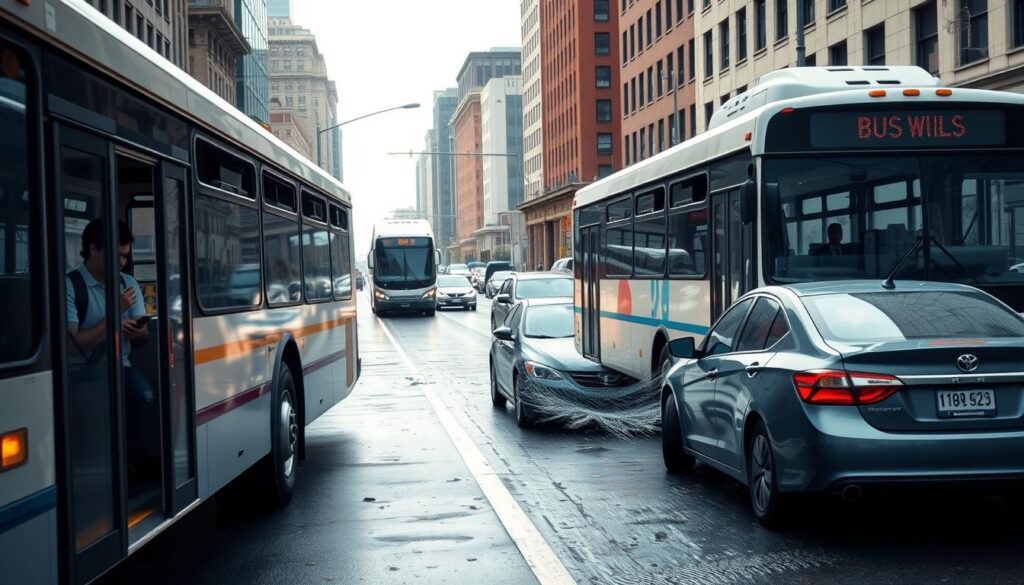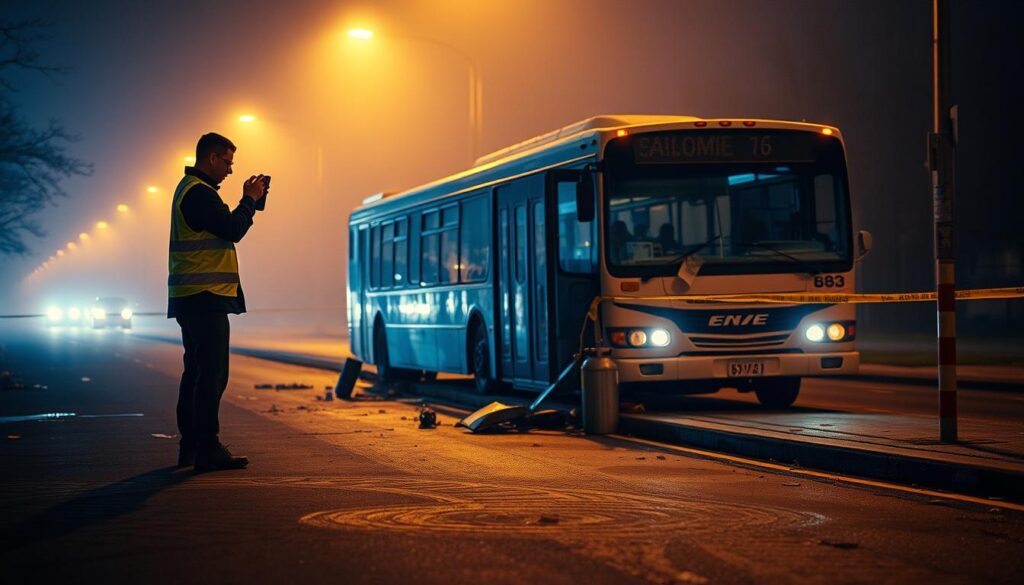What if the key to winning your case isn’t just evidence, but who represents you? In Illinois alone, 805 public transportation collisions occurred last year, leading to 461 injuries and 10 fatalities. Shockingly, most victims never receive fair compensation despite clear negligence.
These cases are rarely straightforward. Unlike standard injury claims, they involve strict deadlines, multiple liable parties, and complex regulations. Insurance providers and transit agencies often use aggressive tactics to reduce payouts—leaving injured individuals struggling to recover.
Choosing the right legal Bus Accident Lawyer. Specialized knowledge of transportation laws, governmental immunity challenges, and evidence collection can make or break your outcome. Without it, even strong claims risk being undervalued or denied entirely.
So how do you ensure your rights stay protected? The answer lies in partnering with a professional who understands these unique battles. Let’s explore what truly sets successful cases apart.
Understanding Bus Accident Cases in the United States
Recent federal reports highlight a pressing issue in American transportation safety. The FMCSA recorded over 110,000 non-fatal and 5,000 fatal incidents involving large passenger vehicles last year. These numbers reveal systemic risks affecting millions who rely on public transit daily.
Recent Trends in Public Transportation Incidents
School-related collisions account for 40% of deadly crashes, disproportionately impacting young passengers and their communities. Urban transit and interstate carriers contribute to another 38% of severe incidents, often involving complex liability issues. High passenger capacity means single events can injure dozens, overwhelming local emergency systems.
How Injuries Shape Legal Outcomes
Non-fatal crashes create lasting challenges: 85% of survivors face medical bills exceeding $50,000 within the first year. Insurance providers frequently dispute claims, citing shared fault or pre-existing conditions. Without thorough documentation, victims risk losing compensation for rehabilitation or lost income.
Transportation companies often deploy teams to minimize payouts immediately after incidents. This underscores the need for prompt legal guidance to protect evidence and establish clear liability timelines.
Why You Need a Qualified Bus Accident Lawyer
Why does having the right legal expert make such a difference? Commercial vehicle collisions often involve multiple layers of liability that require specialized navigation. Without proper guidance, victims risk missing deadlines, accepting lowball offers, or failing to identify all responsible parties.
How Specialized Representation Changes Outcomes
Professionals in this field know how to analyze crash reports, maintenance records, and driver logs. They uncover patterns like missed inspections or violated safety protocols that casual observers might overlook. This attention to detail strengthens your position during negotiations.
Calculating damages goes beyond obvious costs. A skilled team accounts for future therapies, reduced earning capacity, and emotional distress. They’ll also challenge insurers who blame victims or downplay injuries—common tactics in complex cases.
- Transportation laws and government immunity rules demand precise strategies
- Thorough evidence collection often requires accident reconstruction experts
- Multiple entities (drivers, companies, contractors) may share fault
Seasoned advocates handle everything from filing paperwork to courtroom arguments. Their goal? Secure maximum compensation while you focus on recovery. With strict deadlines and high stakes, partnering with experts isn’t just smart—it’s essential.
Don’t Make These Mistakes When Selecting a lawyer bus accident
Common Causes of Bus Accidents
Understanding why collisions happen is the first step toward prevention. While every situation differs, patterns emerge when examining factors like operator schedules and vehicle upkeep. Let’s break down two critical issues and how they endanger everyone on the road.

Driver Fatigue and Drowsy Driving
Long shifts and tight deadlines push many operators beyond safe limits. Studies show reaction times drop by 20% after 10 hours behind the wheel. This exhaustion leads to drifting between lanes or missing traffic signals entirely.
Companies sometimes prioritize schedules over rest breaks. When drivers aren’t given adequate downtime, their ability to handle emergencies plummets. Passengers and pedestrians pay the price for these rushed decisions.
10 Tips Before Choosing the Right Personal Injury Attorney
Mechanical Failures and Poor Maintenance
Vehicles need regular checks to stay roadworthy. Skipping oil changes or ignoring worn brake pads creates ticking time bombs. A single faulty part can trigger chain reactions during heavy traffic.
Some operators use cheap replacements to cut costs. These inferior components wear faster, increasing risks of tire blowouts or steering malfunctions. Proper inspections could catch most issues before they escalate.
| Cause | Risks | Prevention |
|---|---|---|
| Fatigued Drivers | Delayed reactions, lane errors | Mandatory rest periods |
| Faulty Brakes | Longer stopping distances | Monthly system checks |
| Bald Tires | Hydroplaning, blowouts | Tread depth monitoring |
Other factors like speeding or distracted driving compound these dangers. Transit providers must balance efficiency with responsibility—because cutting corners never ends well.
Types of Bus Accidents in Chicago
From the Loop to Logan Square, Chicago’s neighborhoods each present unique risks for transit-related mishaps. The city’s mix of heavy traffic, tight schedules, and diverse commuters creates hotspots for specific incidents. Let’s break down the most common scenarios affecting riders and road users.

Collisions with Other Vehicles and Multi-Vehicle Pileups
Rear-end crashes often occur when drivers misjudge stopping distances on busy corridors like Lake Shore Drive. Side-impact collisions spike at intersections where visibility is limited. The sheer size of transit vehicles amplifies damage in these events.
Multi-vehicle chain reactions frequently unfold during rush hour. A single sudden stop can trigger chaos, especially near merging zones like the Kennedy Expressway. These complex cases often involve disputed liability between multiple drivers.
Pedestrian, Cyclist, and School Bus Involvement
Busy crosswalks in areas like Wicker Park see frequent close calls. Cyclists risk being sideswiped when sharing narrow lanes with large vehicles. Schools in Hyde Park report near-misses during student drop-offs due to impatient drivers.
Children face dangers when boarding or exiting school transit. Overcrowded seating and sudden braking also lead to injuries onboard. Proper safety protocols could prevent many of these incidents.
Steps to Take Immediately After a Bus Accident
Every second counts when unexpected events disrupt your day. Acting quickly helps protect your rights and creates a clear path toward recovery. Let’s walk through practical measures that make a real difference.

Documenting the Scene and Gathering Evidence
Start by contacting authorities and requesting medical help—even minor discomforts need attention. First responders create official records that strengthen your position later. While waiting, jot down names of witnesses and their observations.
Photos tell powerful stories. Capture vehicle positions, skid marks, and traffic signs. Snap clear shots of visible injuries or property damage. These visuals become critical proof when timelines get disputed.
Don’t discuss details with insurance representatives yet. Instead, keep all medical receipts and visit summaries. Symptoms like headaches or stiffness might emerge hours later, so follow-up care matters. Official reports often clarify who bears responsibility.
Finally, schedule a consultation with someone who knows these processes inside out. They’ll help organize evidence and negotiate fair outcomes. Remember: thorough documentation turns uncertainty into actionable solutions.
Navigating the Claims Process and Compensation Recovery
Securing fair compensation often feels like solving a puzzle with missing pieces. The process demands careful documentation and strategic negotiations to address both immediate needs and long-term impacts. Let’s break down how to build a strong case while avoiding common pitfalls.
Medical Expenses, Lost Wages, and Pain and Suffering
Economic damages cover tangible costs like hospital bills and missed paychecks. Keep every receipt—even pharmacy runs or travel expenses for treatments matter. Future needs often surprise victims:
- Physical therapy sessions lasting years
- Home modifications for accessibility
- Career changes due to permanent limitations
Non-economic damages address invisible wounds. Anxiety, sleep disorders, or strained relationships require expert testimony to quantify. Juries often weigh daily struggles when calculating these values.
Working with Insurance Companies
Adjusters might request recorded statements or push quick settlements. Remember:
- Early offers rarely cover future costs
- Delayed injury symptoms can appear weeks later
- Partial fault claims reduce payouts unfairly
Skilled negotiators counter these tactics by presenting structured evidence. They link medical records to incident reports and use wage statements to prove earning losses. This approach turns vague complaints into undeniable facts.
Challenges Specific to Chicago Bus Accident Claims
Chicago’s transit system moves millions daily, but when collisions occur, victims face unique legal hurdles. These cases often involve overlapping responsibilities and strict timelines that differ from standard injury claims. Let’s unpack what makes these situations particularly complex.
Multiple Liable Parties and Governmental Immunity
Determining fault isn’t always straightforward. A single incident might involve the driver, their employer, vehicle maintenance contractors, or even the Chicago Transit Authority (CTA). Public entities like the CTA often claim governmental immunity—a legal shield against some lawsuits.
However, exceptions exist. If negligence in training or equipment maintenance contributed to the crash, victims can still pursue compensation. Proving this requires detailed documentation of safety violations or protocol breaches.
Special Deadlines for Public versus Private Operators
Timing matters more than you might think. Illinois law gives two years to file against private companies but only one year for claims involving the CTA. Missing this window—even by a day—could forfeit your right to recover damages.
Experienced teams know how to identify all responsible parties quickly. They also handle extra steps like submitting formal notices to government agencies, which private cases don’t require. This precision ensures no opportunity for justice slips away.
How a Bus Accident Lawyer Can Strengthen Your Case
When complex transit incidents upend lives, the right legal strategy becomes your anchor. Specialized professionals bring resources and insights most individuals can’t access independently, transforming chaos into clarity.
Uncovering Hidden Truths Through Evidence
Skilled teams collaborate with reconstruction experts to analyze skid marks, vehicle damage, and road conditions. These details reveal exactly how events unfolded—often contradicting initial reports.
Critical proof like driver schedules or surveillance footage disappears quickly. Your attorneys act swiftly to secure maintenance logs, witness statements, and black box data before they’re altered or lost.
Thorough investigations connect dots you might miss. Was the vehicle inspected recently? Did fatigue or distractions play a role? Answers to these questions build undeniable arguments for accountability.
With experts handling the legwork, you gain space to heal while they negotiate confidently. Their precision turns fragmented facts into victories—ensuring no stone goes unturned in your pursuit of justice.
FAQ
What factors should I consider when seeking legal assistance following an incident involving public transportation?
Concentrate on expertise in public transit matters, familiarity with local legislation, and a proven history of managing claims against organizations such as the Chicago Transit Authority. Seek firms that provide complimentary consultations and emphasize transparent communication.
What is the impact of government immunity regulations on damage claims involving city-operated buses?
Governmental immunity may restrict responsibility for public entities; nonetheless, exceptions are present. An adept attorney may discern loopholes, submit appropriate notices, and negotiate to guarantee equitable pay despite these legal impediments.
Do timeframes vary for incidents involving private shuttles compared to public buses?
Affirmative. Public operators frequently possess abbreviated reporting periods (as little as one year), although private enterprises generally adhere to conventional statutes of limitations. Failing to meet these deadlines may result in the loss of your entitlement to seek damages.
What evidence is essential for establishing negligence in multi-vehicle accidents?
Security footage, eyewitness accounts, black box information, and maintenance documentation all essential. An attorney may issue subpoenas for records, reconstruct the incident, and consult with specialists to ascertain liability among various parties.
Are passengers harmed in school-related accidents able to litigate against the district?
The determination relies on state legislation and the extent to which negligence, such as inadequate driver training or defective brakes, played a role. Educational institutions frequently impose liability limits; however, an attorney may investigate alternate options, including lawsuits against third-party vendors.
What is the standard procedure for insurers regarding claims associated with drowsy driving allegations?
Insurers may minimize the significance of fatigue-related issues. Your legal team can refute by acquiring driver logs, GPS data, and workplace rules to substantiate violations of federal rest regulations or safety measures.
What forms of compensation can I pursue in addition to medical expenses following a severe accident?
You may reclaim lost wages, rehabilitation expenses, damages for mental suffering, and diminished earning potential. In instances of egregious carelessness, punitive damages may be imposed to hold reckless operators responsible.
What is the significance of timely action in incidents involving bikers or pedestrians?
Crucial evidence, such as surveillance footage, might vanish rapidly. Prompt investigation safeguards evidence of motorist negligence, roadway dangers, or malfunctioning crossing signals that led to the event.

